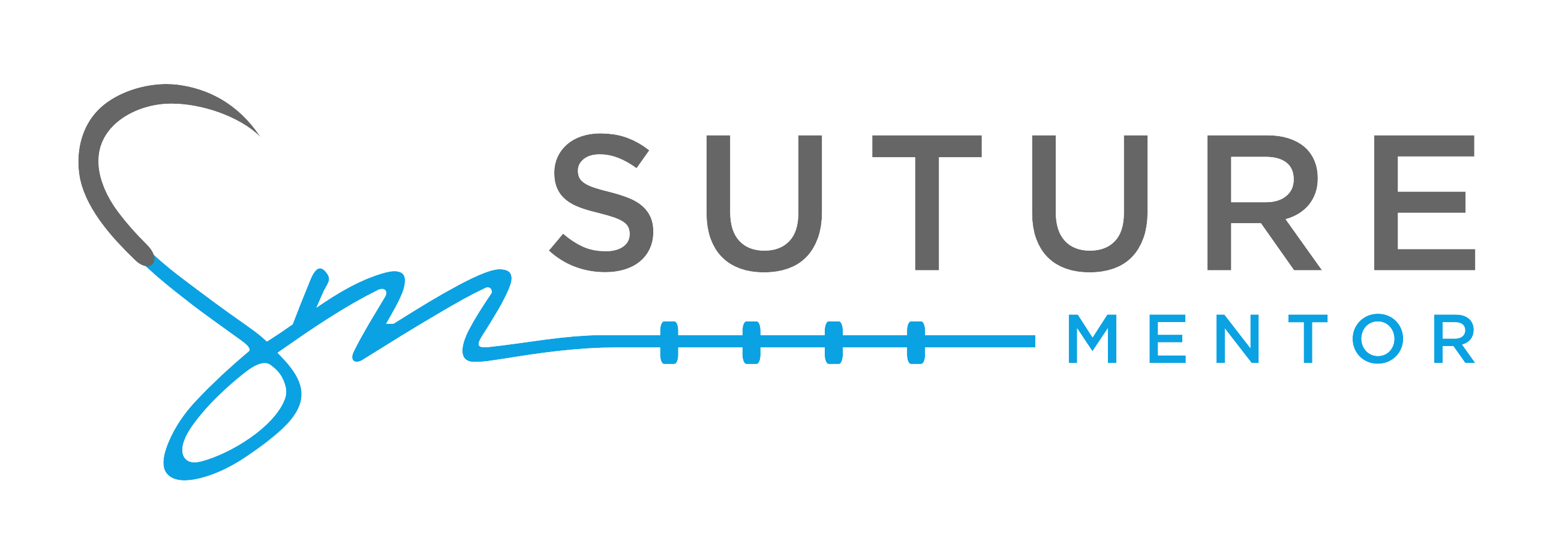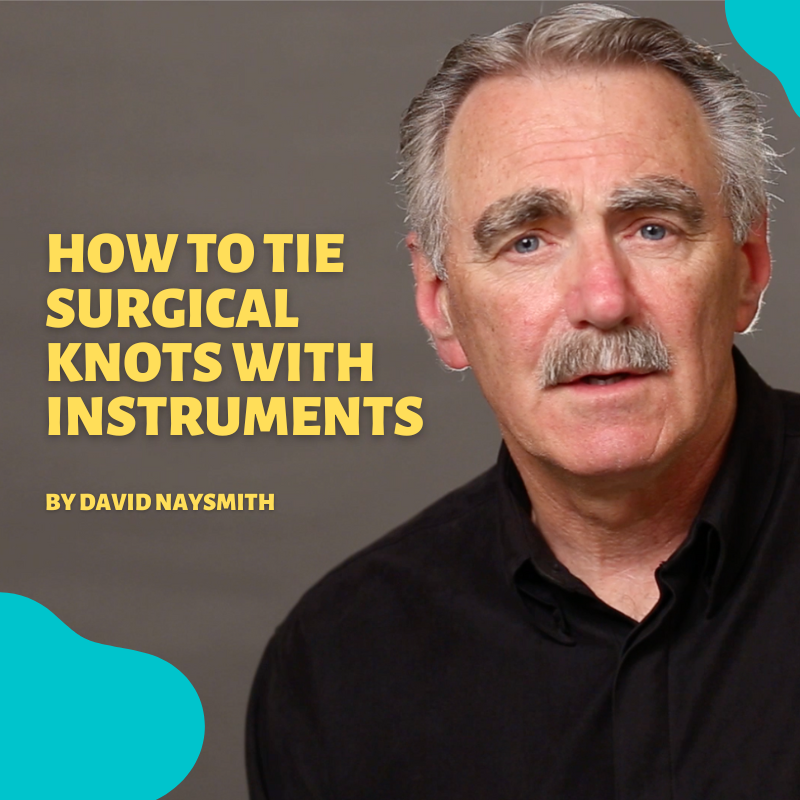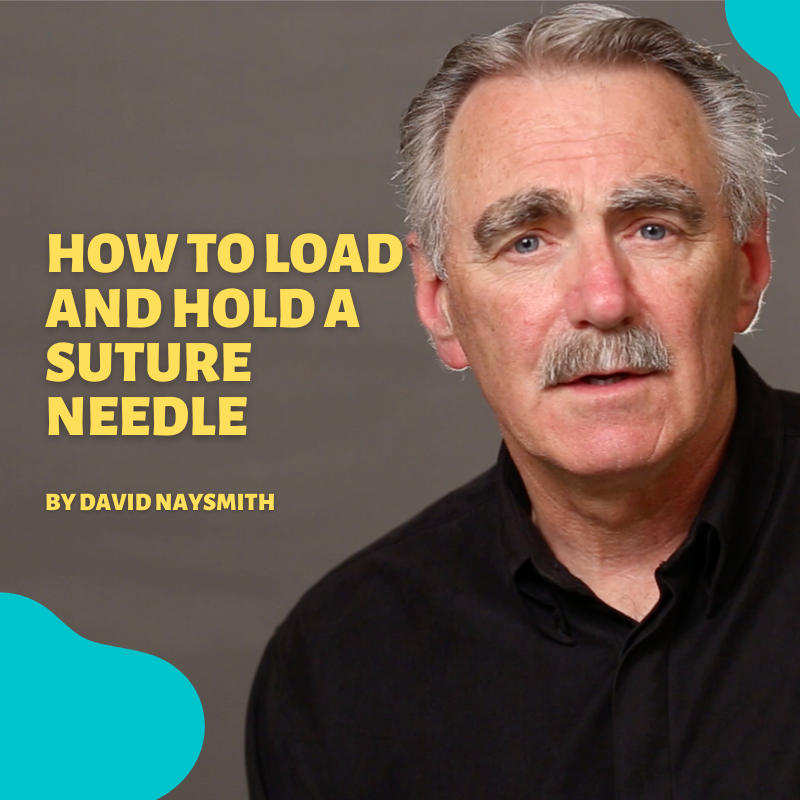TYING SQUARE AND SURGICAL KNOTS
- the square knot
- the surgeon’s knot
Well tied knots are essential in holding wound edges together until healed and in controlling tension on the wound edges - not too tight and not too loose.
WHAT YOU WILL LEARN
- How to tie a square knot using instruments.
- How to tie a surgeon's know using instruments.
SUTURE INSTRUMENTS & SUPPLIES REQUIRED

- Needle driver (aka needle holder)
- Scissors
- A suture on a curved needle (pictured, a 4/0 silk)
- 3/0 or 4/0 is best as it is easy to see the knot. And, a braided suture, such as silk, holds knots well and is easy use when learning.
- An artificial skin substitute
- Pictured - suture pad from the Suture Mentor Suture Practice Kit.
- However, you can also use some heavy felt or the old standby – an orange or banana skin.
HOW TO TIE SQUARE KNOT USING INSTRUMENTS

Figure 2
The key to successful knot tying in surgery is to tie square knots (fig. 2 - the middle knot). If you are familiar with knot tying for other purposes, this is the same as a reef knot.
Note that the two white portions of the knot tuck under the purple loop at the top, and the two purple portions are superficial to the white loop at the bottom – do not worry about how to do this at this point – just remember that this is the way the knot looks when tied. We will see this again as we move through the mechanics of tying.
When tightened, the square knot lays flat and is difficult to undo or become loose. This is the basic knot used in surgery. Let’s learn how to do it using instruments.
Using the needle driver, pass the stitch through whatever you are using as a suturing surface. We are using the the Artificial Skin Pad from the Suture Mentor Suture Practice Kit (fig. 3). You can use some felt or the skin of an orange or banana.

Figure 3
Do not worry about how the needle is positioned yet. Just get the suture material through the “skin”. Pull it through until you have about 3 - 4 cm (1 - 2 inches) still sticking out (fig. 4).

Figure 4
Keeping this free end short will be of great help in knot tying. It saves suture material but more important is that it saves frustration. To see what I mean, once you learn to tie a knot, try leaving this end long and see how frustrating it is!
Release the needle from the needle driver and take the long end of the suture in your left hand. Hold it with about 12 - 15cm (5 - 6 inches) of length to work with.
(Just let the needle end drop for now. Later you will learn how to gather this up in your left palm).

Figure 5
Keep the needle driver in the right hand. Keeping slight tension only on the long end (fig. 5), lay the needle driver on the suture material keeping the needle driver pointed at the hand holding the long end of the suture.
Using your left hand, gently pull the suture material over the end of the needle driver (fig. 6). If you pull too hard or you have too short an end left on the short end of the suture you will pull it through the “skin” and you will have to start all over.

Figure 6
Lift the tip of the needle driver over the stitch being held by the left hand and reach over to grab the short end of the stitch with the open tip of the needle driver (fig. 7).

Figure 7
Once you close the tip of the needle driver on the free end of the suture you now move to tighten this first throw of the knot.
Each portion of the knot is called “a throw” (fig. 8). NOTE that the hands are crossing in order to get this throw of the knot to lay flat – this is critical – if you don’t do this you will tie a “Grannie Knot” – a bad idea!

Figure 8
Figure 9 shows the first throw completed and about to be tightened. Well done, you have the first throw done.

Figure 9
Now note where your hands are. Open the needle driver and let go of the short end of the suture (fig. 10). Keep very gentle tension on the long end (too much and you will pull the first throw apart). Again note where the hands and the needle driver end up after completing the first throw – they are exactly where they need to be to start the second throw.

Figure 10
Lay the needle driver across the suture, pointing the end at the left hand holding the long end of the stitch (fig. 10). As you did on the first throw, using the left hand pull the suture material over top of the needle driver and reach over with the points of the driver to pick up the short end of the stitch (fig. 11).

Figure 11
Grab the short end of the stitch with the tips of the needle driver (fig. 12).

Figure 12
Now you have the short end of the suture material held in the needle driver and the long end is still in the left hand. To tighten the second throw cross the hands once more to get back to where you started with the first throw (fig. 13).

Figure 13
Do this slowly and look carefully at the knot as it forms. You should see a tiny square (aka reef) knot (fig. 14).

Check to see that, as in the centre image of the first picture of knots (fig. 2) that there are two bits of suture material running over the loop on one side and two bits of suture material running under the loop on the other side - difficult to explain but look carefully and you will see what I mean (fig. 14).
With braided suture (not monofilament) two throws are sufficient if a proper square knot has been placed. I always put one more throw on just to make sure.
With monofilament suture material (nylon or polyethylene or some of the absorbable monofilaments – Monocryl) you should put at least four throws (two square knots - one on top of the other). After the first two throws, to complete the square knot, your hands are in perfect position to start place a second knot (fig. 15).

Figure 15
FINE POINTS
- Once you become familiar with knot tying you will find that the motion of “wrapping the suture material around” the needle driver will become a combination of both wrapping the suture with the left hand and twisting the needle driver around the suture with the right.
- It is important to be aware of the hands crossing -back and forth with each throw. This is what creates a square knot rather than a Granny knot. Once you get going you will see that knot tying is a little rhythm of the hands moving back and forth.
- As you are learning you should also be aware that when the hands cross properly that as you open the needle driver and let go of the short end of the suture that you are in PERFECT position to start tying the next throw (fig 10 and 15).
- How tight is too tight and how loose is too loose when snugging the knot? The knot should be just tight enough to have the skin edges touch and not so tight as to pinch the skin and make the edges of the wounds blanch. Only by practice will you be able to fine tune this.
That’s it for the square knot! Just practice, practice, practice.
HOW TO TIE SURGEON’S KNOT USING INSTRUMENTS
Very often when you are tying a traditional square knot you will find that the first throw always wants to come loose.
This makes tying a tight knot difficult, especially with braided suture material as it holds knots very well and you cannot just pull tighter to snug it down, as you can with monofilament suture material.
There are several ways to deal with this. See the Suture Mentor Suture Course for “locking the first throw” for details.
The most common, and easiest way to deal with this is to use a “surgeon’s knot” for the first throw. This is a simple modification of what you already know about tying square knots. To summarize it – all you do is to put two turns of the suture material around the needle driver for the first throw only. Let’s have a look at it.
Begin just as you did with the square knot – place the suture material through the artificial skin surface you are using. In this case, the SUTURE MENTOR skin pad (fig 16).

Figure 16
Point the needle driver at the left hand that is holding the long end – just as you did for the first throw of the square knot. Then, just as you did with the square knot – wrap the suture around the needle driver (fig. 17).

Figure 17
HERE IT BECOMES DIFFERENT – instead of reaching over to grab the short end, WRAP THE SUTURE AROUND THE DRIVER A SECOND TIME (Fig 18, 19).

Figure 18

Figure 19
Now, with two wraps around the needle driver, reach over and pick up the short end -just as you did with the square knot (fig. 20).

At this point the remainder is exactly like tightening the first throw and finishing with a second throw as you did with the square knot. So, cross the hands to tighten the first throw.
And have a close look at the first throw (fig 21) – see how it differs from the first throw of the square knot (fig 9).

Figure 21
Let go of the short end, check your hand position – you should be set up perfectly to lay the needle driver across the long end of the suture material – pointing the needle driver at the hand holding the long end (fig 22).

Figure 22
Then just place the second throw – exactly as with the square knot. Note: there is just one wrap of the suture on the driver (fig. 23). Cross the hands to tighten the second throw (fig. 24). As you start to tighten the second throw, have a look at the knot (fig. 25) and see how it differs from the square knot (fig. 14).

Figure 23

Figure 24

Figure 25
With a proper surgeons knot two throws will do for braided suture, but I usually place a third or fourth throw just to be sure. With monofilament suture material place at least four throws – a surgeon’s knot with a standard square knot over it.
FINE POINTS
- First of all - why use a surgeon’s knot? We use it when the tension on the skin closure keeps pulling the first throw of a square knot apart – therefore not allowing us to snug the knot down enough to get the skin edges to touch.
- It is simple. It is just two wraps of the suture around the needle drive for the first throw. After that, it is exactly the same as tying the square knot.
That is it for knot tying using instruments.
About our Suture Practice Kit & Course
For more details and some tricks to make life easy including: how to lock the first throw and how to adjust wound edges with the first throw as well as how to do one and two handed knot tying see the Suture Mentor Course that comes with the Suture Practice Kit by Suture Mentor.
The kit comes with many feature including a way to practice tying knots with a two-coloured chord to help you visualize (fig. 26)
Have fun and PRACTICE.

Figure 26




Leave a comment
All comments are moderated before being published.
This site is protected by hCaptcha and the hCaptcha Privacy Policy and Terms of Service apply.